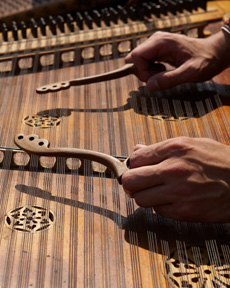

The Prayer of Rest or Quiet
Murray Dueck received his Bachelor of Religious Education from Columbia Bible College. He was an Associate Pastor at Valley Christian Fellowship for seven years. During that time he planted a youth church called God Rock, developed its home group structure, and did itinerant ministry. Murray also oversaw the prophetic ministry in the church during those years, mentoring and discipling prophetic people. Since that time Murray and his wife began Samuel’s Mantle, a training program to help people hear God’s voice. For those of you who have heard Murray speak, you will experience how much the presence of God in his life means to him. Murray currently is writing, doing itinerant work, and teaching Samuel’s Mantle. He is the author of ‘If This Were A Dream, What Would It Mean?’, (great book but currently out of print- but you can receive the training from this book). His newest book is called, “Keepers of the Presence”. The book’s goal is to become your roadmap to developing your unique gift of spiritual sensitivity so you can steward the presence of God wherever you go! I have just ordered a copy for myself and can’t wait to read it. Murray has generously donated a book for someone who writes about their experience of using the contemplative way he has posted. You can review Samuel’s Mantle’s great training and order his new book at www.samuelsmantle.com. I am pleased to introduce you to someone whose teaching has impacted my spiritual journey in such a positive way, Murray Dueck. Enjoy his posting!
The Prayer of Rest or Quiet
By Murray Dueck
I have been asked by Lynda to write a short blog about one of my favorite forms of contemplative prayer. There are lots of methods of interacting with God, maybe as many as there are people, but my favorite is the Orthodox method, handed down by the desert fathers. Technically this prayer would be known as hesychasm, the prayer of rest or quiet. But it comes to us today maybe better known as “The Jesus prayer.”
Many of you know this little prayer “Lord Jesus Christ Son of God, have mercy on me.” And there are a few variations, including a very short one “Lord, mercy.” And I am going to assume here if you are reading this blog you know all about breathing, attention, repeating the prayer, etc…so I am going to focus on an aspect of the orthodox model that often gets over looked. This aspect is the factor of where in our being the orthodox fathers would like us to say our prayer from – our nous. (aka Our inner man), which dwells in our heart. In the Orthodox view it is our heart that steers the ship of our being, (and I think we would agree with that as we are to Watch over our heart with all diligence, for from it flows the spring of life (Prov 4:23). However in our heart, in the orthodox view is the core of our being – our ‘nous.’ We would equate the nous with the ‘inner man’ however the concept is a bit of a difficult concept to grasp, and I must admit I am still struggling with it. But here is the definition given out of the philokalia (a five volume collection of the writings of the desert fathers from approx the 4th to the fifteenth century).
Intellect – nous – the highest faculty in man, through which – provided it is purified – he knows God or the inner apprehension of spiritual perception. Unlike the dianoia, the intellect does not function by formulating abstract concepts and then arguing on this basis to a conclusion reached through deductive reasoning, but it understands divine truth by means of immediate experience, intuition or simple cognition. The intellect dwells in the depths of the soul. It constitutes the innermost aspect of the heart. The intellect (nous) is the organ of contemplation, the eye of the heart.
Yes, that paragraph is confusing. But to be honest those who are drawn to contemplation have been working with this spiritual perception for quite a long time now. We just have not always made a clear distinction between the “dianoia” our reasoning faculty, and our “nous” our inner man – as places in our being to function out of. To be aware of this “shift” from one to the other let us try a few different things. I do not expect all of these activations to work for everyone, but hopefully one of these examples will work for you. First off I want you to think of something administrative that you need to do. Take thirty seconds and spend a few minutes planning your next meeting, think through your to-do list, etc…(so quit reading right now and plan!)….after thirty seconds or so….point with your finger where in your being these thoughts are occurring – and most likely you have pointed at your head. Which I am sure is not a shock. Now let’s try part two of this same exercise. This time I want you to try (I think people coming from different church cultures may need a few different examples for this to make sense, so keep in mind there are more examples below) focusing on our ‘inner man.’ I want you to take thirty seconds and speak God’s word over your life. Just quietly, internally, begin with “My beloved, you belong to me, I love you and…” just let it flow for awhile. (quit reading …now and just go for it)….when you are done (and don’t read further until you are!) point with your finger where in your being you were experiencing that conversation. Was it in your head, or did you point to your heart (where your nous/ inner man is)? (and test it afterward with scripture, confirmation, bounce it off other people, fruit of the Spirit, inner witness, etc.)
Let us try this another way as that last exercise may have been a bit weird for some of you: I want you to pray for someone, someone you really love, that you hope the best for and care about. Pray for them for thirty seconds (again, no peeking)…and point with your finger to where you were experiencing that prayer. More than likely your finger went to your chest – as you have discovered something going on in your inner man.
It may be good before we move on to application to think of a few other ways we experience this (to make sure we include everyone). Have you ever been in church during an open mic time – and you just knew it was your turn to go up front and speak– but you didn’t want to go up? What part of you was arguing? If you could point with your finger where were those argumentative thoughts happening in your being? Now where did you feel the tug of the Lord drawing you to go up front and speak? Most likely in the inner most man – in the heart or chest. This is not as strange an experience as it may seem. When you have made a big decision in your life and you had to wrestle it through you probably needed to come to peace in your heart. Even though your mind was throwing out all kinds of options in regards to your situation it was in the inner man you needed to find that rest. For the orthodox contemplatives – it is from this place they pray.
Here is an extract from the Philokalia written by Callistus Patriarch of Constantinople around 1360 AD.
If you wish to pray as you ought, imitate the dulcimer player; bending his head a little and inclining his ear to the strings, he strikes the strings, skillfully, and enjoys the melody he draws from their harmonious notes.
 Is this example clear to you? The dulcimer is the heart; (where the nous is), the strings– the feelings, the hammer- remembrance of God; the player—the mind. By remembrance of God and of Divine things the mind draws holy feelings from the God-fearing heart, then ineffable sweetness fills the soul, and the mind, which is pure, is lit up by Divine illuminations.
Is this example clear to you? The dulcimer is the heart; (where the nous is), the strings– the feelings, the hammer- remembrance of God; the player—the mind. By remembrance of God and of Divine things the mind draws holy feelings from the God-fearing heart, then ineffable sweetness fills the soul, and the mind, which is pure, is lit up by Divine illuminations.
The Dulcimer player perceives and hears nothing but the melody he enjoys. So the mind, during active prayer, descends into the depths of the heart with sobriety and con no longer listen to aught but God. All his inner being speaks to God with the voice of David: “My soul followeth hard after thee.”
The heart, in this model of prayer, as we practiced pointing our finger earlier – is the focal point of the contemplatives attention.
Here is another example that may be helpful, taken from the Russian Orthodox classic “The Way of the Pilgrim.” In this book the pilgrim has just figured out what Callistus was talking about – and experiences this:
When about three weeks had passed I felt a pain in my heart, and then a most delightful warmth, as well as consolation and peace. This aroused me still more and more and spurred me on to give great care to the saying of the prayer so that all my thoughts were taken up with it and I felt a very great joy. From this time I began to have from time to time a number of different feelings in my heart and mind. Sometimes my heart would feel as though it were bubbling with joy; such lightness, freedom, and consolation were in it. Sometimes I felt a burning love for Jesus Christ and for all God’s creatures. Sometimes my eyes brimmed over with tears of thankfulness to God, who was so merciful to me, a wretched sinner. Sometimes my understanding, which had been so stupid before, was given so much light that I could easily grasp and dwell upon matters of which, up to now, I had not been able to even to think of at all. Sometimes that sense of a warm gladness in my heart spread throughout my whole being and I was deeply moved as the fact of the presence of God everywhere was brought home to me. Sometimes by calling upon the name of Jesus I was overwhelmed with bliss, and now I knew he meaning of the words “The Kingdom of God is within you”.
How to Practice the Jesus Prayer in the Orthodox Way
Here are the steps to this model of prayer. And again it is another style, and don’t feel constrained by it. But for me, it has revolutionized my life. What ‘Pilgrim’ describes above is the true fruit of this prayer and I would recommend to all of you who are interested this wonderful little book “The Way of the Pilgrim” as a great starting point to practice the Jesus prayer from an Orthodox perspective.
- Find the place of the heart, as described above
- From this place love the Lord your God with all your heart
- From this same place say your prayer – focus the words of your prayer not from your head, but from your heart (The classic Orthodox model being “Lord Jesus Christ, Son of God, have mercy on me!”)
- If you wish, when you feel the presence of the Lord stop saying the prayer and just be with God – and if your mind wanders begin again






